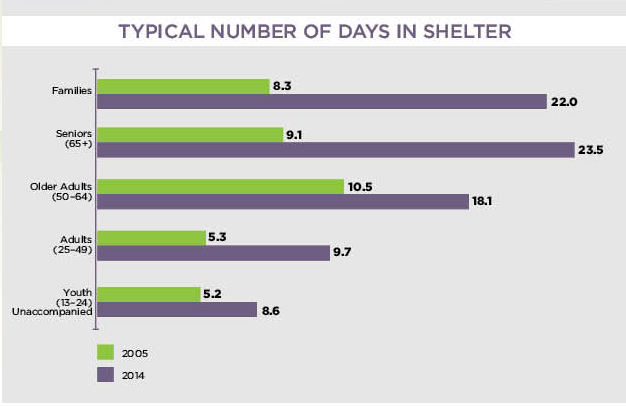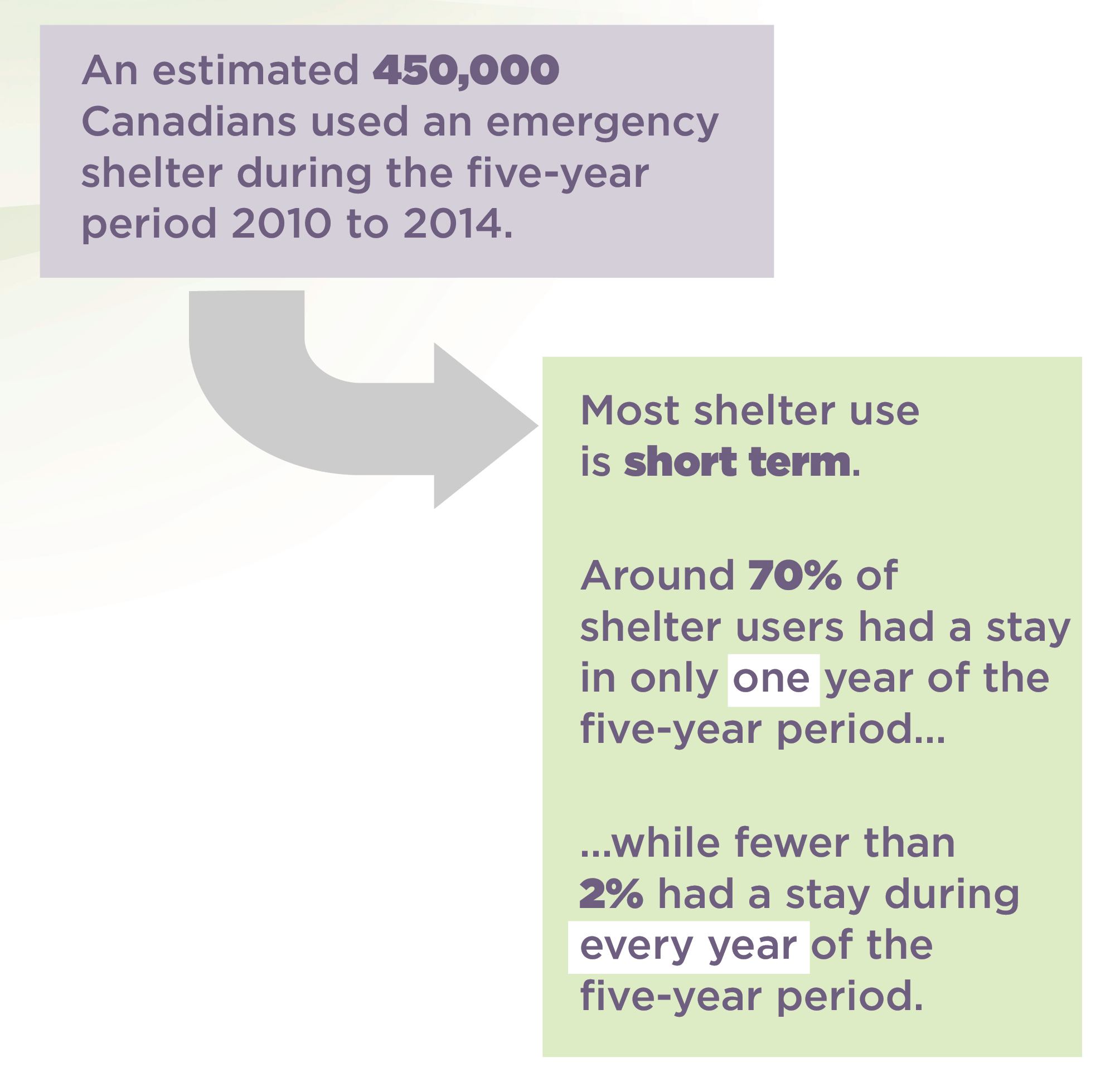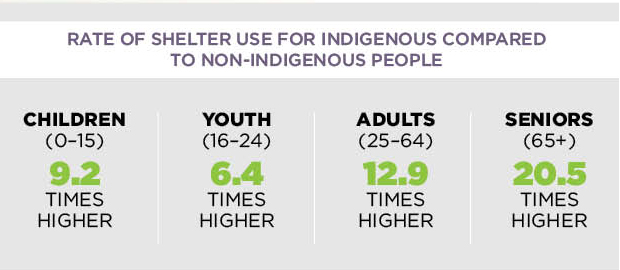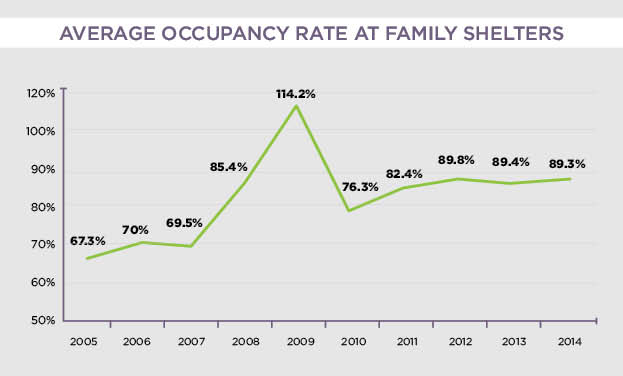Highlights of the National Shelter Study 2005–2014
Introduction
The National Shelter Study 2005–2014: Emergency Shelter Use in Canada, to be published in fall 2016, is the second national analysis using emergency shelter data collected over an extended period of time to establish a baseline count and description of the characteristics of the homeless population using shelters in Canada. The first national shelter study covered the period from 2005 to 2009. The current update of the original study extends the findings to 2014. Starting in 2014, statistics on the Indigenous identity, citizenship and military service of shelter users are available for the first time.
This document provides the key findings of the updated study. It begins by looking at trends in the average shelter occupancy rate, the number of times shelter beds were used, the overall number of Canadians using shelters annually and the length of stay by individuals using Canada’s emergency shelter system. It then examines the demographic characteristics of shelter users and changes in the shelter-using population over the past decade. The study uses emergency shelter data collected electronically by the Homeless Individuals and Families Information System (HIFIS), the City of Toronto, BC Housing and the Province of Alberta. Emergency shelter use is the best available indicator of large-scale trends in homelessness, and the results of this study are important for understanding homelessness in Canada.
Methods
The National Shelter Study is based on anonymous information from 1.9 million shelter stays that occurred at over 200 of the 400 emergency shelters across Canada during a 10-year period.
The study uses a stratified cluster sample of emergency shelters to ensure accurate estimates of the number and characteristics of shelter users. In 2014, the sample included most of the largest shelters in Canada, covering 71.5% of the total emergency shelter beds in the country. The sample is based on emergency homeless shelters and does not include Violence Against Women shelters and transitional housing. The study’s methodology also takes into account people who use more than one shelter.
Key findings
Canada’s emergency shelter system is operating at over 90% capacity
There are about 15,000 emergency shelter beds at 400 emergency shelters across Canada. The number of shelters and beds has changed very little between 2005 and 2014, but demand for shelter beds has increased. On an average night in 2014, 13,857 Canadians slept in an emergency shelter, using over 90% of Canada’s 15,000 shelter beds. By comparison, in 2005, average nightly shelter use had reached just over 80% of capacity.
Figure 1: National shelter occupancy rate

Description of the figure 1: National shelter occupancy rate
| 2005 | 2006 | 2007 | 2008 | 2009 | 2010 | 2011 | 2012 | 2013 | 2014 | |
|---|---|---|---|---|---|---|---|---|---|---|
| Occupancy rate | 82.7% | 82.0% | 79.1% | 85.5% | 94.6% | 83.2% | 86.3% | 91.6% | 91.2% | 92.4% |
More bednights are being used annually by fewer people
Although the annual number of shelter users has fallen from 156,000 in 2005 to 136,000 in 2014, emergency shelters served an average of 800 more people per night in 2014 compared to 2005. Bednights measure the number of times a shelter bed is used in a year. In 2014, over 5 million bednights were used at emergency shelters in Canada, an increase of 300,000 since 2005. This indicates that, although there are fewer people using shelters, they are using shelters more.
Figure 2: Estimated number of annual shelter users

Description of the figure 2: Estimated number of annual shelter users
| 2005 | 2006 | 2007 | 2008 | 2009 | 2010 | 2011 | 2012 | 2013 | 2014 | |
|---|---|---|---|---|---|---|---|---|---|---|
| Shelter users | 156,030 | 150,663 | 146,884 | 151,621 | 146,726 | 141,854 | 137,415 | 141,405 | 134,262 | 136,866 |
Figure 3: Estimated number of annual bednights used

Description of the figure 3: Estimated number of annual bednights used
| 2005 | 2006 | 2007 | 2008 | 2009 | 2010 | 2011 | 2012 | 2013 | 2014 | |
|---|---|---|---|---|---|---|---|---|---|---|
| Bednights used | 4,759,753 | 4,668,304 | 4,463,715 | 4,783,768 | 5,263,182 | 4,526,169 | 4,686,469 | 5,012,230 | 4,970,010 | 5,057,813 |
Duration of shelter stays has increased, especially among families and people 50 and over
Demand for shelter beds has increased due to longer stays, especially by families and people aged 50 and over. A typical shelter stay by a family was over 20 days in 2014, twice as long as a stay by individuals. People over 50 typically spend eight or nine more days in shelter than people under 50. However, stay lengths have increased for all types of shelter users since 2005.
Figure 4: Typical number of days in shelter

Description of the figure 4: Typical number of days in shelter
| Type of shelter user | Families | Seniors (65+) | Older adults (50–64) | Adults (25–49) | Youth (13–24) unaccompanied |
|---|---|---|---|---|---|
| 2005 | 8.3 | 9.1 | 10.5 | 5.3 | 5.2 |
| 2014 | 22 | 23.5 | 18.1 | 9.7 | 8.6 |
Most Canadians using emergency homeless shelters do not have repeat stays
While the duration of shelter stays has increased over the period from 2005 to 2014, only a minority of shelter users repeatedly use shelters year after year. Over the five-year period from 2010 to 2014, an estimated 450,000 people used an emergency shelter. Fewer than 2% of this total used a shelter in each year of the five-year period. During any one-year period, up to 70% of the people who use shelters are first-time shelter users, and most use a shelter only once.
Figure 5: Most shelter use is short term

Description of the figure 5: Most shelter use is short term
An estimated 450,000 Canadians used an emergency shelter during the five-year period from 2010 to 2014.
Most shelter use is short term.
Around 70% of shelter users had a stay in only one year of the five-year period, while fewer than 2% had a stay during every year of the five-year period.
Among shelter users, the number of individuals under the age of 50 is down while the number of individuals over the age of 50 is up
Although the total number of individuals using shelters annually is down by almost 20,000 since 2005, a closer look at the statistics reveals that shelter use changed over time by age group.
- Among children, the number of shelter users has been stable since 2010, with an average of 6,000 children using emergency shelters each year.
- The number of shelter users between the ages of 25 and 49 dropped significantly between 2005 and 2014. This accounts for the overall decrease in shelter users. Despite this decline, individuals aged 25–49 continued to be the largest group of shelter users. Over half (52.7%) of shelter users fell into this age group in 2014.
- The number of youths using shelters decreased from 32,757 in 2005 to 25,501 in 2014, a 20% decline in use by this group. By contrast, the number of shelter users aged 50 and over has increased by more than 50%, from 18,856 in 2005 to 28,951 in 2014.
- There are now more 50- to 64- year-olds using shelters than youth. By comparison, there are relatively few shelter users aged 65 and over, comprising just 3.2% of all shelter users. However, the number of seniors using shelters has nearly doubled from 2,244 in 2005 to 4,332 in 2014.
Figure 6: Estimated number of annual shelter users by age group

Description of the figure 6: Estimated number of annual shelter users by age group
| Age group | 2005 | 2006 | 2007 | 2008 | 2009 | 2010 | 2011 | 2012 | 2013 | 2014 |
|---|---|---|---|---|---|---|---|---|---|---|
| Children (0–16) with an adult | 5,339 | 5,764 | 6,422 | 6,327 | 8,167 | 6,007 | 5,446 | 6,277 | 6,425 | 5,780 |
| Youth (13–24) unaccompanied | 32,757 | 31,270 | 31,250 | 30,313 | 31,256 | 27,225 | 26,256 | 25,362 | 23,653 | 25,501 |
| Adults (25–49) | 95,820 | 90,931 | 86,824 | 89,304 | 81,463 | 77,836 | 75,245 | 76,449 | 71,113 | 71,824 |
| Older adults (50–64) | 18,856 | 19,779 | 19,442 | 22,214 | 22,071 | 25,049 | 25,953 | 28,640 | 28,088 | 28,951 |
| Seniors (65+) | 2,244 | 2,214 | 2,338 | 2,466 | 2,566 | 3,505 | 3,721 | 4,028 | 4,454 | 4,332 |
Figure 7: Age groups (2014)

Description of the figure 7: Age groups (2014)
| Age group | Children (0–16) with an adult | Youth (13–24) unaccompanied | Adults (25–49) | Older adults (50–64) | Seniors (65+) |
|---|---|---|---|---|---|
| 2014 | 4.20% | 18.70% | 52.70% | 21.20% | 3.20% |
The gender breakdown of shelter users has not changed
Between 2005 and 2014, there has been no change in the percentage of males and females using shelters. In 2014, 72.4% of shelter users were male and 27.3% were female. It should be noted, however, that Violence Against Women shelters have not been included in this study. Females using shelters are, on average, younger than males. The average age for males is 40, compared to 36 for females. Moreover, the percentage of female shelter users decreases for older age groups. Fewer than one in five seniors using shelters are women.
Figure 8: Gender by age group*

Description of the figure 8: Gender by age group*
| Age Group | Children (0–16) with an adult | Youth (13–24) unaccompanied | Adults (25–49) | Older Adults (50–64) | Seniors (65+) |
|---|---|---|---|---|---|
| Male | 50.80% | 62.40% | 72.10% | 78.70% | 81.30% |
| Female | 49.10% | 36.80% | 27.60% | 21.10% | 18.60% |
*percentages are shown for male and female responses only.
In 2014, nearly 3,000 shelter users reported having served in the military
In 2014, 2.2% of shelter users—an estimated 2,950 people—reported having served in the military. This number is slightly higher than the estimate of 2,250 reported in The Extent and Nature of Veteran Homelessness in Canada, published by Employment and Social Development Canada. Shelter users reporting military service were more likely to be male. Over half of females reporting military service were under age 30. Males reporting military service tended to be older on average than other shelter users.
Over 6,000 non-citizens used a shelter in 2014
About 5% of shelter users reported that they are not Canadian citizens, including 5,036 permanent residents or immigrants, 1,095 refugees and 562 temporary residents (student, work or visitor visa). Refugee shelters are not included in this analysis. Typical shelter stays for non-citizens were about five days longer than for shelter users with Canadian citizenship.
Indigenous people are 10 times more likely to use a shelter than non-Indigenous people
It is estimated that between 38,080 and 45,820 Indigenous people used a shelter in 2014. Overall, statistics show that the rate of shelter use for Indigenous people is 10 times higher than for non-Indigenous people. When compared with rates of shelter use by non-Indigenous people, shelter use is 20 times higher for Indigenous seniors and 13 times higher for Indigenous adults. Thirty-two percent of Indigenous shelter users were female compared to 23.5% of non-Indigenous shelter users.
The percentage of shelter users who report Indigenous ancestry varied widely by community, from less than 5% in some suburban communities to over 90% in many northern communities. In each of the communities where data are available, Indigenous people are over-represented in homeless shelters compared to their percentage in the general population.
Figure 9: Rate of shelter use for Indigenous compared to Non-Indigenous people

Description of the figure 9: Rate of shelter use for Indigenous compared to Non-Indigenous people
The rate of shelter use for Indigenous children (0–15) is 9.2 times higher than for non-Indigenous children.
The rate of shelter use for Indigenous youth (16–24) is 6.4 times higher than for non-Indigenous youth.
The rate of shelter use for Indigenous adults (25–64) is 12.9 times higher than for non-Indigenous adults.
The rate of shelter use for Indigenous seniors (65+) is 20.5 times higher than for non-Indigenous seniors.
Family shelters continue to operate at high capacity
The National Shelter Study 2005–2009: Emergency Shelter Use in Canada reported an increase in the use of family shelters, with the average occupancy rate at family shelters exceeding 100% in 2009. This peak use did not continue in 2010. However, the average occupancy rate at family shelters was 86.3% in 2014, much higher than the 67.3% occupancy rate reported in 2005. The high occupancy rate at family shelters is driven by increasingly long shelter stays by families. A typical stay at a family shelter increased from 8.3 days in 2005 to 22 days in 2014. Although families tend to experience much longer shelter stays than individuals, they are less likely to use shelters repeatedly, with only 8.9% of families using a shelter more than once in 2014. Nearly 90% of families using emergency shelters are headed by single females.
Figure 10: Average occupancy rate at family shelters

Description of the figure 10: Average occupancy rate at family shelters
| 2005 | 2006 | 2007 | 2008 | 2009 | 2010 | 2011 | 2012 | 2013 | 2014 | |
|---|---|---|---|---|---|---|---|---|---|---|
| Average Occupancy Rate | 67.3% | 70.0% | 69.5% | 85.4% | 114.2% | 76.3% | 82.4% | 89.8% | 89.4% | 86.3% |
Conclusion
Rising demand for shelter beds in the face of static capacity
As of 2014, the average occupancy rate at Canada’s emergency shelters had risen to over 90% — an increase of almost 10 percentage points since 2005. However, the overall capacity of Canada’s emergency shelter system has not changed significantly. Although the annual number of individuals using shelters has fallen over the 2005 to 2014 study period, shelters are being used more intensely. Overall demand for shelter beds has increased due to longer shelter stays.
While stay lengths have increased since 2005 for all shelter users, there has been a marked increase in stay lengths for families and seniors. The age composition of the shelter-using population has also changed. The number of youths and adults aged 25–49 using shelters has fallen while the number of adults aged 50 and over has increased.
Since April 2014, the Homelessness Partnering Strategy has focused on the Housing First approach, which strives to move individuals, particularly the chronically and episodically homeless, directly into permanent housing. This study covers the period before Housing First was introduced nationally and provides a strong baseline for future research to assess the impact of Housing First on shelter use.
The National Shelter Study 2005–2014: Emergency Shelter Use in Canada, which will include a more in-depth analysis of this data, along with new information from the first coordinated national point-in-time count, will be available in fall 2016.
Learn more about the Homelessness Partnering Strategy.
Report a problem on this page
- Date modified:
